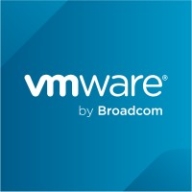

Find out what your peers are saying about Dell Technologies, Broadcom, Nutanix and others in HCI.
We can say 10% is the approximate amount of savings because most of the things are automated and streamlined, so the manual work is eliminated in most cases.
When we send an email, an engineer is assigned within 15 to 20 minutes, and we get on a call to resolve the issue.
Priority one issues are usually addressed by engineers within one to two hours.
Recently, support has been less friendly and slower, especially after the company was acquired by Broadcom.
If we have issues, the support tends to be unreliable
The scalability of Nutanix Cloud Infrastructure (NCI) deserves an eight out of ten rating, as there is no solution that is 100% efficient and there is always room for improvement.
Scaling is easy, whether it is hyperconverged or a three-tier architecture.
VMware vSphere is highly scalable in terms of the number of users and the number of servers it can handle.
It is a highly scalable solution.
Compared to VM, we find it most stable.
Regarding stability, I would rate Nutanix Cloud Infrastructure (NCI) a seven out of ten.
It is a very stable hypervisor solution.
While they are generally stable, if outages occur, they tend to be due to brands like HP or Dell, not VMware vSphere itself.
Mostly we don't have issues, but sometimes we have faced some stability issues because of some bugs and some CPU compatibility issues with Intel CPUs.
We hope Nutanix can integrate inside our current license module.
I would suggest that Nutanix Cloud Infrastructure (NCI) should develop their own P2V (physical to VM) tools instead of requiring users to rely on third-party solutions.
They should add AI features in the future.
The cost changed from perpetual to subscription, and there is a need for alternative solutions.
Another area is the stability during upgrades from older versions to newer versions, where we face issues.
Sometimes, it is difficult to find documentation for specific tools and solutions.
The pricing is renewed every year, at almost $100,000 per year.
It costs more compared to VMware due to different licensing areas.
At first, it is cheaper than cloud services, so the cost is a major benefit.
Many customers are trying to avoid it due to its high cost.
Costs significantly increased from perpetual to subscription, with prices rising by two to three times over three to five years.
The solution is too expensive.
When technology development or devops teams request server provisioning, the setup time has been reduced from hours to less than 20 minutes.
The replication method between Nutanix clusters is a valuable feature.
It is easy to use, and it's easy to maintain.
The vMotion feature is beneficial for online migration of virtual machines from one host to another without downtime.
The tool is highly available, which is crucial for implementing critical applications requiring 24/7 availability.
I always use VMware vSphere vMotion; we work with this feature all the time. vMotion is very useful; that's why we use the virtualization.
| Product | Market Share (%) |
|---|---|
| Nutanix Cloud Infrastructure (NCI) | 9.6% |
| VxRail | 15.8% |
| VMware vSAN | 13.9% |
| Other | 60.7% |
| Product | Market Share (%) |
|---|---|
| VMware vSphere | 16.8% |
| Proxmox VE | 16.1% |
| Hyper-V | 15.2% |
| Other | 51.89999999999999% |




| Company Size | Count |
|---|---|
| Small Business | 91 |
| Midsize Enterprise | 77 |
| Large Enterprise | 82 |
| Company Size | Count |
|---|---|
| Small Business | 174 |
| Midsize Enterprise | 137 |
| Large Enterprise | 256 |
Nutanix Cloud Infrastructure (NCI) is a top-ranking HCI software, cloud management tool, and Software Defined Storage (SDS) tool that is marketed as the foundation for users' hybrid clouds. It offers a powerful and secure hyperconverged infrastructure to deliver all data and applications at any scale and on any cloud. The solution offers a complete software stack that allows users to unify their hybrid cloud infrastructure.
NCI’s services include computer, storage and network, hypervisors and containers, and deployment in public or in private clouds. The product also comes with built-in resilience, disaster recovery capabilities, self-healing, and high-security capacities. It provides further deployment flexibility through several software and hardware options and platforms. NCI includes a full set of enterprise capabilities. It can also be deployed on a wide range of servers from popular manufacturers.
The capabilities of the product are categorized into three main groups:
Outside of these categories, NCI also offers other capabilities:
Nutanix Cloud Infrastructure (NCI) Features
Nutanix Cloud Infrastructure (NCI) offers its customers various features and tools in each of the previously mentioned categories. The available features for users currently include:
Nutanix Cloud Infrastructure (NCI) Benefits
The product offers various benefits to users who utilize its capacities. Some of these include:
Reviews from Real Users
According to Gerhard J., an IT manager at Q4 Fuel, Nutanix Cloud Infrastructure (NCI) provides serious reliability and stability across the entire system makes for ROI.
A solutions architect at a computer software company describes NCI as a stable, straightforward to set up, and scalable solution.
VMware vSphere is a versatile virtualization platform known for its ease of use, flexibility, and high availability. It supports seamless migration, optimal resource allocation, and centralized management, making it highly suitable for diverse infrastructure needs.
VMware vSphere is widely adopted for its virtualization capabilities that enhance hardware efficiency and ensure minimal downtime through features like High Availability and Distributed Resource Scheduler. Despite criticisms about high licensing costs and limited fault tolerance, it remains a preferred choice due to its stability, scalability, and robust integration options. Users appreciate its efficiency in managing virtual machines and hosting enterprise applications, although challenges with web client performance and hardware compatibility are noted. Organizations often look for better integration with cloud services and enhanced automation and scalability.
What are the core features of VMware vSphere?
What benefits and ROI can businesses look for?
VMware vSphere is implemented across sectors like healthcare, finance, and education for server virtualization, data center management, and private cloud creation. Its use in facilitating business-critical operations ensures high availability and efficient resource use, supporting both development and production environments.
We monitor all HCI reviews to prevent fraudulent reviews and keep review quality high. We do not post reviews by company employees or direct competitors. We validate each review for authenticity via cross-reference with LinkedIn, and personal follow-up with the reviewer when necessary.